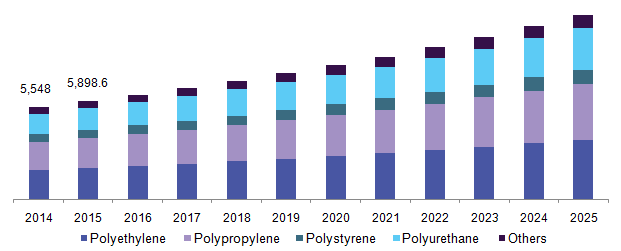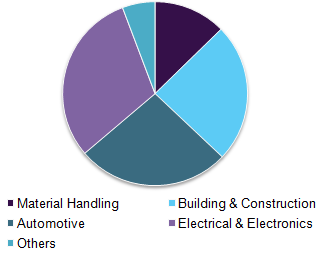- Home
- »
- Plastics, Polymers & Resins
- »
-
Structural Foam Market Size, Share, Global Industry Report, 2018-2025GVR Report cover
![Structural Foam Market Size, Share & Trends Report]()
Structural Foam Market Size, Share & Trends Analysis Report By Product (Polyethylene, Polypropylene, Polystyrene, Polyurethane) By Application, By Region, And Segment Forecasts, 2018 - 2025
- Report ID: GVR-1-68038-962-3
- Number of Report Pages: 147
- Format: PDF, Horizon Databook
- Historical Range: 2014 - 2016
- Forecast Period: 2017 - 2025
- Industry: Bulk Chemicals
Industry Insights
The global structural foam market size was estimated at USD 25.41 billion in 2016. The rapid expansion of the building & construction industry is expected to be a key factor driving the industry growth. Additionally, the growing demand for key applications such as construction, automotive, and material handling, and consumer electronics, particularly in the BRICS (Brazil, Russia, India, China, and South Africa) nations, is expected to drive structural foam market over the forecast period.
Structural foams are considerably lighter than other solid plastics and exhibit better weight to strength ratio. They are used to impart durability, conductivity, heat resistance, and strength in various applications including wind turbines, automotive components, insulation of building roof, doors, columns, etc.
U.S. structural foam market revenue by product, 2014 - 2025 (USD Million)

The intense use of foams in material handling equipment used for short distance transportation of goods within the manufacturing plant itself and in various other packaging applications is anticipated to drive the product demand in material handling application segment. Rising use of the product in shipbuilding, wind power, and consumer goods, is expected to foster growth in other applications segment.
However, fluctuating prices of raw materials and increasing preference for biobased plastics as a reliable alternative to non-biodegradable foam are considered to be the restraining factors. Furthermore, big enterprises have set up supply partnerships and depicted higher forward and backward integration in the value chain. However, they also need to cope up with challenges such as higher fuel prices, offering premium quality products at affordable prices, and face competition from other local manufacturing firms.
Product Insights
Polyethylene accounted for over 44.8% of the global structural foam demand in 2016 and is expected to maintain the largest market share during the forecast period. Polyethylene foam is a lightweight, durable, resilient, and a closed-cell material mostly used in the packaging of fragile goods, automotive, etc. owing to its exceptional insulation and vibration dampening properties.
Rigid polyurethanes are used as structural material, and this segment is expected to emerge as the fastest growing segment by 2025 with a CAGR of 5.7% in terms of volume. These materials exhibit superior properties such as toughness, lightweight, and resilience. The material is also resistant to a number of chemicals and moisture making it suitable to be used at various temperatures and thus find applications in insulting the buildings. Owing to their large scale utilized in the construction segment, they are likely to grow at a faster rate especially in Asia Pacific and Latin America.
The other products used as structural foam materials include bio-based plastics, polycarbonate, polyvinyl chloride, acrylonitrile-butadiene-styrene, Noryl, and thermoplastic elastomers among others. Companies such as BASF, Evonik, Armacell, etc. are involved in the product innovation.
Application Insights
The global demand for structural foam has seen a rise in the automotive sector. Use of this material in the automotive segment is expected to grow rapidly owing to ongoing research for developing lightweight composites for vehicles. Currently, structural foams are injected into different parts of an automobile body-side joints, pillars, sills, underbody cross-car structure, longitudinal structure or frame rails, engine cradles, side rails, door panels, and hydroformed reinforcements. However, the segment is projected to increase at a CAGR of 5.8% from 2017 to 2025.
Global structural foam market revenue by application, 2016 (%)

Building & construction segment is expected to emerge as the largest application segment and is anticipated to account for around 41% of the total demand by 2025. Growing construction spending, particularly in the emerging markets of Latin America and Asia Pacific, is expected to boost the product in the application segment.
Furthermore, wind turbines are the emerging application segment for these foams as they ensure high compressive forces and shearing, high temperature resistance, and maximum stability & rigidity at minimum weight. Additionally, these materials help achieve excellent aging properties & long-term stability, and lower operational costs. Companies, such as Dow Chemical, Armacell, DIAB, and BASF, offer cores and other sandwich composite structures for wind turbine components.
Regional Insights
North America emerged as the largest market for structural foam and accounted for more than 53% of the global revenue in 2015. Increasing use of these lightweight materials in wind turbines, building, and construction is expected to drive the industry in the coming years. The region was followed by Europe that accounted for over 20% of the total demand in 2015.
The use of advanced materials in the building & construction coupled with the favorable laws has led to the rise in the utilization of these products in this region. Asia Pacific is anticipated to emerge as the fastest growing market with a CAGR of 5.9%. Developing economies in the region such as India, China, and Indonesia have been witnessing high economic growth.
Rising population and increasing living standards have stimulated the automotive demand in the region. Moreover, government support to increase the FDI flow, in the form of financial incentives and tax benefits, in countries such as India has helped in higher regional penetration.
Structural Foam Market Share Insights
Key market participants include Armacell International S.A., Diab International AB, Evonik Industries, etc. Companies such as Covestro AG, Gurit Holding AG are expected to emerge as prominent players owing to their product portfolio expansion and operational strategies. Furthermore, they are also focusing on providing customized products, which are application specific, lightweight, and exhibit better insulation and heat resistance.
Key market players primarily focus on expanding their presence in the value chain to achieve a competitive advantage over others. They supply their products to end-use industries such as medical, building & construction, household, material handling, automotive, and electrical & electronics.
Report Scope
Attribute
Details
Base year for estimation
2016
Actual estimates/Historical data
2014 - 2016
Forecast period
2017 - 2025
Market representation
Volume in kilo tons, revenue in USD Million and CAGR from 2017 to 2025
Regional scope
North America, Europe, Asia Pacific, Central & South America, Middle East & Africa
Country scope
U.S., Germany, UK, France, China, India, Japan
Report coverage
Volume &revenue forecast, competitive landscape, growth factors and trends
15% free customization scope (equivalent to 5 analyst working days)
If you need specific market information, which is not currently within the scope of the report, we will provide it to you as a part of customization
Segments covered in the reportThis report forecasts revenue growth at global, regional & country levels and provides an analysis on the industry trends in each of the sub-segments from 2014 to 2025. For the purpose of this study, Grand View Research has segmented the global structural foam market on the basis of product, application, and region:
-
Product Outlook (Volume, Kilo Tons; Revenue, USD Million, 2014 - 2025)
-
Polyethylene
-
Polypropylene
-
Polystyrene
-
Polyurethane
-
Others
-
-
Application Outlook (Volume, Kilo Tons; Revenue, USD Million, 2014 - 2025)
-
Material Handling
-
Building & Construction
-
Automotive
-
Electrical & Electronics
-
Others
-
-
Regional Outlook (Volume, Kio Tons; Revenue, USD Million, 2014 - 2025)
-
North America
-
The U.S.
-
-
Europe
-
Germany
-
The U.K.
-
France
-
-
Asia Pacific
-
China
-
India
-
Japan
-
-
Central & South America
-
Middle East & Africa
-
Share this report with your colleague or friend.
![gvr icn]()
NEED A CUSTOM REPORT?
We can customize every report - free of charge - including purchasing stand-alone sections or country-level reports, as well as offer affordable discounts for start-ups & universities. Contact us now
![Certified Icon]()
We are GDPR and CCPA compliant! Your transaction & personal information is safe and secure. For more details, please read our privacy policy.
We are committed towards customer satisfaction, and quality service.
"The quality of research they have done for us has been excellent."





